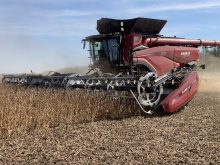MANITOBA
SOUTHWEST
Canola below average
Winter wheat harvest is almost 100 percent complete.
Yields are in the 40 to 50 bushel per acre range. Producers are now harvesting spring cereals and canola.
Canola yields are below average. Spring cereal yields are average to below average.
Greenfeed crops planted into unseeded acres are suffering from lack of moisture.
Rainfall is needed for all late seeded crops and pastureland.
CENTRAL
Late crops need rain
Read Also

Bunge’s crop mix is changing
Bunge has predominantly been a soybean processing firm, but that’s about to change after the merger with Viterra with softseed processing and grain merchandising gaining ground.
Producers are harvesting in dry, warm conditions. Canola yields are 10 to 55 bu. per acre.
Green seed has been a problem for some producers because of the hot weather during swathing.
Wheat yields are 30 to 60 bu. per acre. Quality is average.
Rain is needed to aid late seeded crops, revive pastures and prepare fields for winter wheat seeding.
NORTHWEST
Soybeans sprayed
Wheat yields are 40 to 65 bu. per acre. Quality is very good with protein content reported at more than 13.5 percent around Swan River.
Canola yields are 25 to 40 bu. per acre.
Soybeans in the Dauphin area are at the R5 to R6 stage. Fields around Ste. Rose are in R7 stage.
Producers have had to spray to control aphids.
EASTERN
Pastures in trouble
Soil moisture is rated as dry throughout the region.
Hot and dry weather this summer has restricted canola yields.
Producers reported yields of less than 10 bu. per acre in some fields. Seed size is below average.
Spring wheat and oat harvests are 75 percent complete. Spring wheat yields are 40 to 60 bu. per acre.
Oats are yielding 70 to 100 bu. per acre.
Pastures are rated as poor to fair because of lack of rainfall.
INTERLAKE
Lygus bugs hit alfalfa
Spring wheat is yielding 35 to 45 bu. per acre. Oat yields around Teulon and Arborg are good, with bushel weights around 36 to 44 pounds.
Canola fields have been swathed. Yields from combined crops are 25 to 35 bu. per acre.
Lygus bugs are causing problems on alfalfa seed crops. Some producers have sprayed to control the insects.
SASKATCHEWAN
SOUTH
Crops advancing
Warm weather has allowed crops to mature and producers to make significant harvesting progress.
Precipitation was nil to 55 millimetres in southeastern Saskatchewan, with the average being 8.5 mm. Kisby, Manor, Stoughton, Moosomin and Radville have received substantial rainfall.
The southwest averaged 1.4 mm. Rockglen, Cadillac, Bengough and Lisieux reported significant rainfall, from five to eight mm.
The rain was generally welcomed because late-seeded crops have been affected by the warm, dry conditions. About 21 percent of the crop is in. Twenty-seven percent is swathed or ready to straight cut.
CENTRAL
Harvest progressing
The region has received little precipitation. The most rain fell Aug. 28 and 30. The Kerrobert area received the most Aug. 28 while the Naicam area reported significant rainfall Aug. 30. Warm, dry conditions have allowed producers to harvest 18 percent of the crop.
Thirty-seven percent of crops are ready to be straight cut, including 91 percent of winter wheat and 51 percent of canola.
Fifteen percent of canola and nine percent of mustard have been harvested.
NORTH
Crops ready for harvest
The region received little rainfall. The Hafford area received the most rainfall. Barthel, Meadow Lake, Radisson and Speers all received rain. Eight percent of the crop has been harvested in the northeast, while 35 percent is ready to be cut.
Only five percent has been harvested in the northwest and 19 percent is ready to be straight combined. Thirty percent of the canola is ready to straight cut.
ALBERTA
SOUTH
Rain slows harvest
Rain last week halted harvest across most of the region.
Dryland crops from Iron Springs to Enchant are above average but not bin busters. Yields of 34 bushel for canola, 52 to 55 bu. for winter wheat and 70 bu. for two-row barley were reported on dryland crops. Yields are higher on irrigated acres.
Harvesting of hybrid canola is starting and about half the commercial canola crops in the region are swathed. Low protein levels are reported in hard red winter wheat, but quality is good.
In general, 12 to 15 percent of cereals and oilseeds are swathed or harvested. Winter wheat is done and the pea harvest is about 50 percent complete. Corn needs more heat.
CENTRAL
Harvest behind slightly
Small showers and cool, cloudy weather limited harvest activity.
Light frost was reported, but crop damage is not expected.
Harvest is slightly behind average progress for this time of year. Some canola is swathed near Lacombe and Stettler, but most farmers are waiting for greater seed colour change. Some pre-harvest treatments in cereals were reported.
Harvest is expected to be general this week if weather co-operates.
A pocket of bertha armyworms was reported in the region. Spraying will depend on the anticipated harvest date. Ergot has appeared in some wheat, but the extent of the problem isn’t yet known.
NORTHEAST
Maturity varied
Peas and canola are being swathed in the Camrose and Bonnyville areas. Farmers continue to handle the challenge of crops being in two maturity stages because of varying spring weather conditions.
Average to above average yields are still expected if frost holds off.
Second cut haying has started and quality looks better than the first cut because of better weather.
NORTHWEST
Crops to mature
Some swathing has begun but progress is slow. Crops still need to gain maturity before harvest can begin in earnest.
Harvest progress is behind the long-term average for the region.
Some silaging is underway, as well as desiccation of grain crops.
No significant rain fell in the past week. Yield projections indicate an average crop if frost stays away, but temperatures did drop briefly to -2 C last week near Sangudo.
Pastures are in good condition.
PEACE
Frost risk looms
Growers in the northern Peace are swathing canola, but progress is slower in the southern part of the region.
Pre-harvest treatments on wheat are starting, but crops in general are two weeks from maturity, making growers nervous about frost.
Historically, first frost in the region occurs between Sept. 11 and 20.
Some second cut hay has been harvested and quality is mostly good to excellent.














